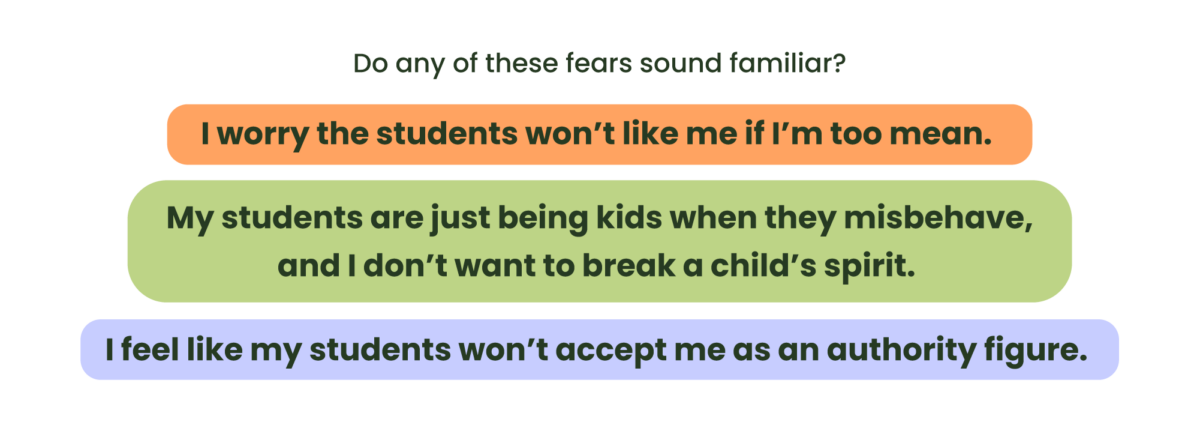Hey there, we’ve got something pretty startling to tell you: When it comes to setting up (and executing on) behaviour management plans, most brand-new teachers are going to make a lot of mistakes. Hold on, do NOT panic.
We’re also here to tell you that it’s OK!
Absolutely no one is perfect.
In fact, the teachers on the Teach Starter team all made their fair share of behaviour management mistakes in those early years in the primary classroom, and we’ve decided it’s time to share them all. Our team of veteran teachers wants to share all we have learned along the way about fixing them.
Maybe these stories will help create a new behaviour management plan, or maybe they’ll just help you avoid a few of the pitfalls we stumbled over along the way.
Behaviour Management Mistakes
Letting imposter syndrome take hold
This one is a biggie, so get ready to roll up your sleeves and dive in with us.
We get it. You are a brand-new teacher. You just walked out of your prac, and you’re still feeling a little bit shocked that they have given you your own classroom. You! They’ve given YOU a whole classroom and 23 fresh-faced children, each silly and goofy and perfect in their own way!
Are they sure they made the right decision? Did they really mean to hire that other Miss Jenkins, but the paperwork got mixed up?
If any of those questions cross your mind in those first days in the classroom, say hello to imposter syndrome.
You may not realise you have imposter syndrome, or not know it by name, but feeling like a fraud is just about every first-year teacher’s worst enemy. This very real psychological phenomenon — it was first recognised by psychologists back in 1978 — often takes hold when we are feeling out of our element and out of control. It can affect anyone, regardless of their job, but imposter syndrome is quite often experienced by high achievers (hey, that’s you!).

We’re not psychologists, and we’re not in the business of diagnosing people on the internet — even lovely new friends like you — but we can tell you these are pretty classic signs of imposter syndrome. Feeling inadequate or unprepared can stand in the way of setting up classroom management systems, including the all-important behaviour management strategies we’re going to be talking about here.
But there is good news here. Pushing through imposter syndrome starts with reframing the way you think about your status and insight as a new teacher.

You aren’t an imposter at all. You’re a qualified teacher who has the authority and skill to create boundaries and set up classroom rules and procedures to ensure students have a safe, structured, and beneficial learning environment.
Going old school
It’s a tale as old as time. A first-year teacher walks into the classroom and sets up a classroom management plan based on inspiration they found on social media and borrowing teaching tactics the veteran teachers in the school are employing. Hey, it works for those teachers, so why can’t it work for them?
What if we told you that one of the best things about graduate teachers is they have fresh ideas? Now is the time to take all of those things you learned at uni and put them into practice — even if they’re the opposite of what happened in your childhood classrooms.
Curriculum changes, and educational research constantly teaches us more about how children learn. Just take a look at some of the more recent developments and understandings that were never considered before:
- Studies show us that even simple morning greetings can make an impact on student behaviour. How about adding a morning greetings display that allows students to pick the greeting they like best?
- Recent research has shown the human attention span is decreasing, and the average year 1 student can now stay on task for just 7 minutes. Print off a set of quick brain break activities students can choose from to give their brains a much-needed rest before diving back into the lesson.
Old-school behaviour management methods are finding their way out of the classroom for a good reason. Studies have shown that collective discipline, time-out corners and the use of public shaming are a detriment to student learning and overall mental health.
Don’t be afraid to trust your gut and take your own road when it comes to handling student behaviour and developing your own classroom management strategies. If a teammate uses a strategy, and it feels wrong to you, then chances are your instinct is right.
Focusing only on the negative
There’s a balance that teachers have to strike when it comes to calling out student behaviour. Too little, and your students will walk right over you. Too much, and the very behaviours you’re trying to quash will increase tenfold.
As a graduate teacher, it’s common to fear that students may not respect your authority, and that can prompt you to over-correct, calling out every minor infraction in the name of classroom control.
This can trigger a vicious cycle of student misbehaviour, which prompts negative attention from the teacher, which in turn causes students to shut down and shut themselves off from you. A pattern of negative reinforcement is created, resulting in more misbehaviour down the line.
Instead of focusing on the negative all the time, balance your corrections with positive reinforcement, creating a ratio that favours positive engagement. For example, for every negative interaction a student receives, follow up with three positive interactions.
This doesn’t only apply on an individual student level — it can help you to build student rapport on the whole-class level too. Make a habit of celebrating the positives in your classroom such as smooth transitions between lessons. These tips from a few of the teachers on our team may help as well:
- When you do need to address a student’s misbehaviour, do so away from the other students whenever possible. This can help you avoid the entire class witnessing a battle of wills between you two.
- When you decide to give students a break or an exception on larger infractions, talk to them about why you’ve made this decision. This helps you build relationships and establishes parameters for your students.
- Avoid power struggles. If a student (or students) refuses to comply with rules or follow directions, they do not earn bonuses or special privileges. Period.
- Celebrate wins. Use a classroom reward system to ensure there’s collective responsibility over the classroom environment, and mark successful wins.
- Collect compliments! Set up a classroom poster that tracks compliments from your colleagues about whole class behaviour to remind students that other people see their good behaviour too.
Not being the boss
Most new teachers who’ve struggled in their first year (even confident ones) have this experience in common, and generally, it ties right into the feelings of imposter syndrome. The fact is that you’ve spent your life in an education system where others have told you what to do, so telling others — even our students — what to do and when to do it doesn’t always come naturally.

These are all fears new teachers have. How do we know? The classroom teachers on the Teach Starter team had them too.
It’s worth noting that these fears all come from a good place — a focus on respecting the students and the all-important teacher-student relationship. But you deserve respect too, and your students deserve a well-run classroom free of disruptions.
You’ve probably heard more than a few veteran teachers remind you that you aren’t there to make friends with your students. While this is true, there’s something to be said for rapport building and how this plays hand-in-hand with behaviour management. After all, if a child doesn’t think you care about them, why would they follow your rules?
You might not be there to make friends, but you are there to love, nurture, and guide your students through the most critical years of their education.
No matter what other teachers say, there is one thing you should always remember…

Your job is to help mould these little minds and to prepare them for that great wide world outside of the classroom. To do that, they need you to model structure and create boundaries.
And let’s face it — building a strong behaviour management system won’t just help your students. Studies show that challenging student behaviour is one of the top things teachers say caused them to burn out. Using effective behaviour management strategies like on-the-spot behaviour redirection will help you retain classroom authority and help you feel more at home in your classroom.
Trying to find your inner boss? Try these strategies:
- Redirect single off task students individually and quietly.
- When you need the whole class to quiet down or get on task, having a list of attention-getters will save you a lot of frustration. Print off attention-grabbing phrase cards for ideas, and teach your students to respond with a specific response when you call out a particular word or phrase.

Expecting overnight compliance
When you start the year off with your classroom rules and expectations, you expect them to stick, right?
In a perfect world, they would!
But you know by now that you’re teaching in the real world and a real classroom, where children need to hear rules repeated numerous times before they’re able to follow them. First-year teachers will often lay out the rules for their class once, then move directly into the curriculum. This leads to frustration for the teacher and for the students who don’t understand why they’re now facing constant correction.
Think about it this way: You wouldn’t expect the little ones in your maths class to understand fractions after just one lesson. Surely they need more than one lesson on inappropriate and appropriate classroom behaviour.
Rules and expectations should be revisited several times over the first few weeks of school and again when students return to the classroom after their holidays. Be careful not to drill students on the rules as it can feel draconian. Instead, here are some ways to make this necessary part of your behaviour management more fun:
- Work with your class to build a list of rules. When students have buy-in, they’re more likely to follow the rules!
- Actively practice listening skills to help students get back in the habit when they get back to school.
- Make identifying problematic behaviour a game that students play in small groups.
- Play behaviour charades to help students work out what’s appropriate in the classroom!
Sticking with a strategy that doesn’t work
We’ve talked about a lot of different behaviour management strategies that might work for your classroom — from using reward systems to setting rules as a class.
But what happens when you’ve picked a classroom management system, and it’s just not working? Do you really want to change management systems mid-school year? Yes!
Many new teachers get caught up in trying to make a plan work, and while we’re all for a can-do attitude, we’re here to offer you the grace you should be giving yourself. It’s not just OK to give up on a strategy that isn’t working with your class. Sometimes it’s absolutely necessary.
Behaviour management is not one-size-fits-all. What works for one set of students may not work for another, and the plans you made before you met these children may just not be the right plans.
Do not be afraid to start over. You — and your students — will have a better chance at a successful school year if you do!
Comparing ourselves to other teachers
Have you been looking around at the other teachers, the veterans who have been there for years? It seems like they only have to give mischievous students a single look, and suddenly they’re sitting up straight, hands neatly folded in the lap and lips zipped shut.
But we’re here to tell you that it’s hardly that simple. A classroom that runs like a well-oiled machine based on a teacher’s eyes alone is rare indeed.
And while you’re looking around your classroom at all those individual children with their own unique personalities, remember that teachers are as unique as the students we teach. Our behaviour management styles are all bound to be different, and so are the boundary lines we draw with our students.
Instead of asking yourself ‘Am I as good as Ms. Jones at managing student behaviour?’ try asking “’Is this management plan working for me? Is my classroom running the way I’d like it to run?’
Everyone accepts something different in their classroom. Deciding where you stand philosophically on what acceptable behaviour looks like is part of forming your teacher identity.
A final word on other teachers: If there is a teacher in your school who you outright admire, might we suggest plucking up your courage and asking for a few tips? They might have a few suggestions based on their years of experience or particular experience with some of the children in your classroom.







Comments